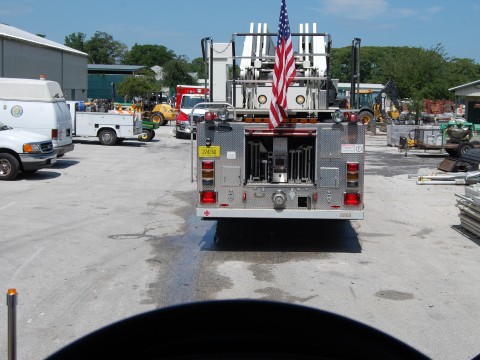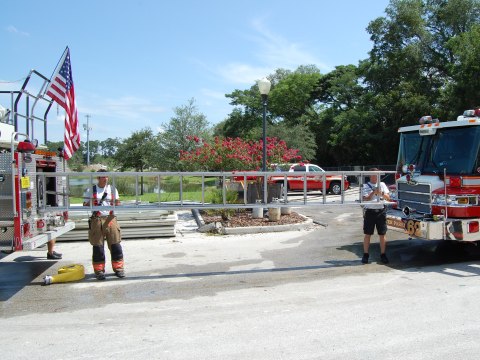
Engineer Jeff Spinelli from Winter Park (FL) came up with an interesting thought. He wanted to know what the exact distance the Engine had to park away from the Truck “looked like†from the driver’s seat. What he found from his point of view (his engine, his seat location, etc) that if he couldn’t see the rear tires of the Truck he was too close and the ladders would not be able to be removed. Every rig and every person are going to be a little different. So go ask the Engineers of the other rigs what it looks like for them. If they don’t know for sure go out and check. It’s an interesting question and a quick little drill. While having the discussion it’s another good time to bring up the whole apparatus positioning discussion (ie: Truck gets the front, etc.) Obviously when in doubt have the Engine park with plenty of extra room, but this idea works well for the dialed-in Engineer when working on tight streets. Not bad for an “Engine†guy…

23 thoughts on “Engine’s Point of View”
Leave a Reply
You must be logged in to post a comment.

What a guy. We get crowded all the time (or have to hike with equipment from parking a distance away) and it’s nice to know that there’s an Engine guy thinking of the big picture and EVERYONE on the fire ground. I’m sure there are lots of E-men out there with like thinking, unfortunately they aren’t on MY shift! I will pass this along and maybe they’ll see the light.
Remember, the distance will be different if the Truck is on its outriggers. Meaning…If it up, stop before the tires disappear.
When we arrive the outside guy deploys the 24′ ladder most of the time, one thing that I have done while working the outside position is to pull another ladder out part way which I hope just gets those engine drivers thinking when they pull up and see it.
our procedure is to put the engine at a slight angle as well, this provides truckies extra protection and more room getting ladders. For the engine crew better and easier deployment of crosslays.
“Hook June 3rd, 2009 2:20 pm
our procedure is to put the engine at a slight angle as well, this provides truckies extra protection and more room getting ladders. For the engine crew better and easier deployment of crosslays.”
great post and my engine driver does the same thing. we dont often use crosslays unless we are hitting the FDC but putting the rig at a angle does just what you said. provides protection for the truck from cars and will give them a little more room for getting ladders out. all providing that the engine was behind the truck.
great post from winter park (fl)
On our tower ladder I took a road cone with rope attached to it that is 2 feet longer than our longest ladder while stowed and attached it to the back of the truck. When the truck arrives on scene the operator deploys the cone behind the truck and the 2nd due engine can park right at the cone and the truck can get all of it’s ladders out.
How about letting the Engine in first?
Some non-firemen have solved this as well, though I am not /sure/ of the details. Power company overhead maintenance trucks, for example, have sometimes got lines on the window that correspond to a hood marker for some distance measurement or other having to do with how far from the curb they have to park to keep the outrigger deployment on the road (I think, could be swing of the boom also).
If you were interested, it would seem plausible to do similar; just pick a part that doesn’t change in size (width, probably, as if at an angle as discussed above it’s not that important anymore) and make a reference mark on the side so different drivers know to move their head back or forward to the right angle for the window ticks.
I would just donkey kick the engine out of the way. Then I would pull the electric meter. (That’s the last time, I swear!)
I am with Jon on this one- How about the engine first? ALL (yes all) our engines have a rear mount 55′ squirt. ALL (yes all) our trucks are center mount towers. With the engine first, he stops at the 1/4 corner with his turntable. It can cover front and side 4. The truck follows and puts his turntable at 1/2 corner giving us master stream coverage on 3 sides in an IDEAL world without overhead lines and trees.
Great Thinking. You dont have to have a truck to benefit from this trick. If your engine has high side compartments and internal ladder storage your second due needs to think about leaving space.
I like the cone on a rope trick, that may show up on our tower in the near future!!!
Another idea or atleast what we practice on our truck is pulling the 35 or largest ladder of the back so the engine has to park at the least the length of or largest ladder and were able to pull any others we need
Our quint’s ladders are stored laying flat through the tank. Naturally the 35′ is on the bottom with the 25′ in the middle and the roof ladder on top. The simplest thing for us to do is definitely the cone on a rope. I will be bringing this up to my captain for sure.
In our dept the engine company leads the way and the ladder company follows since its larger and slower. The engine will take position in front of the building and the ladder will usually take position on the B/C or C/D corner and set up the 100 ft tower. And our rescue trucks always take position on the opposite side the street so as not to clog up the streets. So with our ladder truck being set up on a coner we have full access to all of our ladders from the 35 foot to the 15 foot roof ladder.
Jon June 3rd, 2009 4:57 pm
How about letting the Engine in first?
Now theres an idea!!!!! Imagine that?
Hopefully there’s more than just one engine responding. If you let the first engine in, there’s still others that may be parking behind you. Seems as though this is where the above parking tip would kick in. Thanks for the good ideas all around.
If the engine parks too close, put one through the windshield. They’ll learn.
What a great idea, i’m always telling the other guys that i work with to leave enough room and of course they never do. Mabye this will help them remeber or at least be able to judge it a little better.
You know the public ignores those “Keep back 200 (or whatever) feet” signs.
How about a sign just for the drivers of other fire vehicles?
http://i39.photobucket.com/albums/e193/funepics/keepback.jpg
Of course the distance would depend on how much..err…personal space you require.
🙂
I think everyones taking this alittle too far. My feeling is an engine pulls up and has a 200 ft. crosslay they can work with, our engines carry a 300 ft lay too. So there is no need for the engine to pull right up behind the truck.
That’s how this whole thing started, the second truck went “too far”.
😉
Ideally you would want the first due engine in ahead of the truck. The engine will pull past the fire building giving the engine officer a 3 sided size up of the fire building and giving them room to stretch their lines. The truck can than take the front of the building. The third due apparatus can park on an angle leaving enough room for my guys to get the needed ladders out and go to work. Im on a volunteer department so it varies on who is first due. Bottem line if your pulling up behind a truck, leave a little more than a trucks distance a part and you should be good.
the engine (hose wagon) should be first, but it should have nothing to do with the length of the cross lay (or whatever you call them). The engine carries the hose and should have some static loads to be able to make the stretch from where ever they have to park. Give the truck room on both ends!